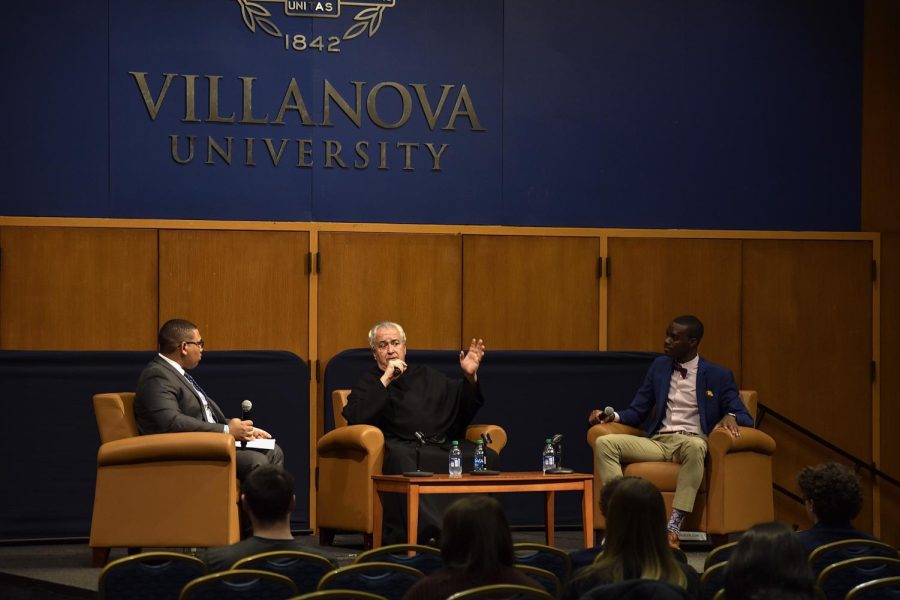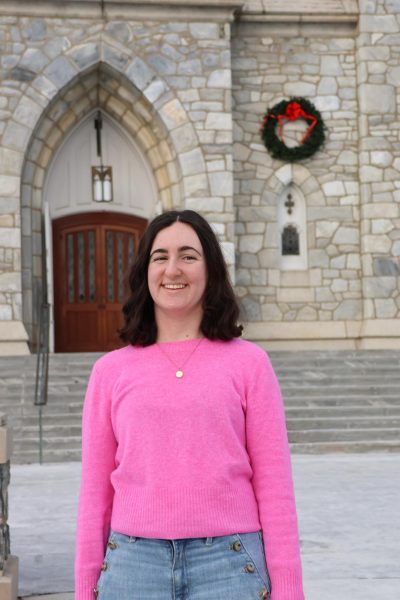SGA Hosts Town Hall with Father Peter
Brian Luppy/ Villanovan Photography
Father Peter joined SGA officers for a Town Hall.
March 29, 2023
On Thursday night, Villanova University President Rev. Peter M. Donohue, O.S.A., Ph.D joined the stage alongside Student Body President Jose Garcia-Orozco and Campus Climate Committee Chair and Senator Dean Millard for the annual Town Hall.
At the event, hosted by the Student Government Association (SGA) in the Villanova Room, Garcia-Orozco and Millard asked Fr. Peter a series of questions related to campus issues on behalf of the student body. Members of the audience also had the opportunity to ask their own questions during a supplementary Q&A session.
In preparation for the Town Hall, Garcia-Orozco and Millard worked with SGA members to determine the most pressing campus issues, posting a question submission box on the SGA Instagram page. Topics ranged from ongoing campus construction to financial aid, housing, campus safety and more.
“Students always ask good questions, and we always want to continue the transparency between the president’s office and student body,” Garcia-Orozco said. “I’m in this position to advocate for students no matter their background, so the questions we picked were important and we get them all the time.”
Fr. Peter began the evening by introducing himself and describing his longtime connection to Villanova, beginning as an undergraduate student, then a tenured professor, then, due to his love of teaching, only reluctantly applying for the position as University President, which he has held since 2006.
Garcia-Orozco and Millard’s first question pertained to the progress of Fr. Peter’s initiatives for building the future of Villanova, such as the Campus Master Plan and the Ten-Year Strategic Plan, “Rooted. Restless.,” which he launched in 2019.
“Finalizing the Campus Master Plan in conjunction with the Strategic Plan is an important priority for me,” Fr. Peter said. “I love planning out the future, and the Master Plan and Strategic Plan look at how to continue to improve and grow the facilities to serve the needs of our students and future generations.”
Fr. Peter emphasized that Villanova’s campus will be subject to significant physical change, with the completion of Villanova’s largest new academic building, CEER, and the upcoming addition of a new library.
Millard then transitioned the conversation to Fr. Peter’s perspectives on creating a more welcoming campus community for students of all backgrounds, asking about his plans for continuing to foster Villanova’s diversity, equity and inclusion (DEI).
“DEI is a huge part of the Strategic Plan and should flow through every aspect of the University,” Fr. Peter said. “It’s very closely connected with all of our Augustinian values and traditions. DEI should be part of the fabric of who we are as a campus community.”
Garcia-Orozco then asked about plans to make Villanova more affordable, particularly for students of color and those from low-income families. According to Garcia-Orozco, SGA frequently hears from students concerned about financial aid. The questions came in the wake of a 4.25 percent tuition increase for the 2022–23 academic year.
Fr. Peter explained that Villanova is in the process of raising money to meet the financial need of more students.
“We estimate that we would have to add to the operating budget about 15 million dollars a year to answer one hundred percent financial need,” he said.
The next topic of discussion was dining. Garcia-Orozco and Millard mentioned student interests in Villanova’s plans to expand accommodations for students with dietary restrictions, as well as continue introducing more eco-friendly dishware.
“Post-COVID, the biggest challenges we’ve had are in the area of food,” Fr. Peter said.
Fr. Peter added that the roots of some of the setbacks currently surrounding campus Dining Services are understaffing and national supply chain issues.
Millard then gave Fr. Peter an opportunity to bring up a new subject of his own choosing, asking for his opinion on the biggest problem facing Villanova students today.
Referencing the widespread struggle with social isolation during the pandemic and the harmful nature of social media, Fr. Peter responded with his concerns about mental health among the student population. He then lightened the mood, drawing laughs from the audience with a story about startling a phone-absorbed student who recently walked into Fr. Peter’s car.
Millard further inquired about ways students struggling with mental health can seek support on campus, as in-person appointments at the Counseling Center are limited and often must be made two weeks in advance.
“The Office of Student Life now has a free, 24-hour online counseling service that has been very successful,” Fr. Peter said. “There are lots of people on campus who have the ability to help students with their issues, not only the Counseling Center, but also Campus Ministry, Student Life and the Learning Support staff.”
Finally, Millard asked about Villanova’s plans to expand student housing as the school becomes more competitive.
“Villanova might be more popular in terms of admissions, but we haven’t grown the student population in years,” Fr. Peter said.



